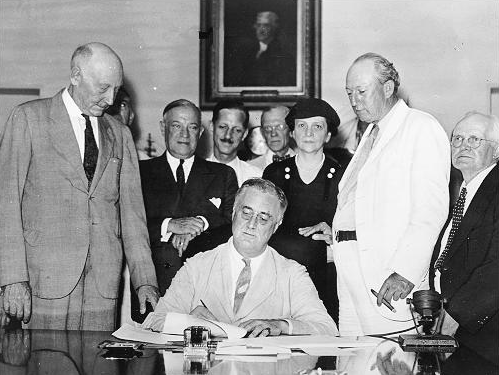
An economist and social worker and the Secretary of Labor during the New Deal, the first woman cabinet member.
Her Life: The Woman Behind the New Deal from the Frances Perkins Center
- Born in Boston, Massachusetts and graduated from Mt. Holyoke college.
- Led the battle against the Great Depression: the Wagner-Peyser Act revitalized the U.S. Employment Service, the Fair Labor. Standards Act set a floor under wages and a ceiling over hours, the Wagner Act protected workers' right to organize.
- She established the Labor Standards Bureau.
- Through effective relationships with the state governments, she strengthened labor law enforcement by the states.
- She was also the principal architect of the Social Security Act.
- Served 12 years, 3 months (longer than any other Secretary)
- Went on to serve as a Member of the Civil Service Commission
- Department of Labor Headquarters named after her in 1980. Inducted into the Labor Hall of Fame in 1988.

Link to the Social Security Administration website Social Insurance for U.S., for the transcript of a radio speech Perkins made in February 25, 1935 in which she describes for the first time what would become Social Security.

Click here for a 45 minutes speech about Perkins' legacy given by Kirsten Downey at the Kansas City Public Library.
The Social Security Act of 1935
The Social Security Act from Marist College
 |
| President Roosevelt Signs the Social Security Act, August 14, 1935. |
The Social Security Act established a system of old-age benefits for workers, benefits for victims of industrial accidents, unemployment insurance, aid for dependent mothers and children, the blind, and the physically handicapped.
- First time the federal government instituted a program to alleviate social ills
- Did not cover about 1/2 of workers in the U.S. economy
- Agricultural workers and domestic workers (who were in large part African Americans) were excluded
Public programs designed to provide income and services to individuals in the event of retirement, sickness, disability, death, or unemployment.
In the United States, the term social security refers specifically to the programs established in 1935 under the Social Security Act.
In particular, it refers to the social insurance portion of that act, which uses contributions made by workers and employers to provide income to people and their families during retirement or in the case of involuntary unemployment, disability, or death.
- The Social Security Act was a comprehensive law consisting of 11 titles, or subjects.
- Six of the titles detailed specific programs, while the others established methods of taxation to fund the programs, formed the organization of the controlling government body (the Social Security Board), and established guidelines for the creation of public health facilities.
- The six original programs were Old-Age Assistance, Old-Age Benefits (for retirement), Unemployment Compensation, Aid to Dependent Children (ADC), Maternal and Child Welfare, and Aid to the Blind.
- To most Americans Old-Age Benefits for retired adults became synonymous with the term social security.
- The federal government alone operated this program, whereas states ran the others with grants from the federal government.

- Watch FDR sign the Social Security Act.
The Social Security Act
How Corporate Moderates Created the Social Security Act and Then Tried to Undermine It Later, G. William Domhoff, University of California Santa Cruz
Key Dates in the History of Social Security

Primary Sources
Go here for the text of the Act
A Brief Explanation of the Act by the Federal Government (1936)
Social Security: Early Promotional Posters from the Social Welfare Project, Virginia Commonwealth University

 Learning Plans
Learning Plans
The Social Security Act from EDSITEment
Taxes in U.S. History from the Internal Revenue Service
Investigate the Social Security Act from Historical Thinking Matters
Debating Social Security: Understanding and Evaluating Perspectives on the Social Security Act of 1935

Canva Poster about her
Is the World Ready for a Guaranteed Basic Income? Freakonomics Radio (April 13, 2016)
Comments (0)
You don't have permission to comment on this page.